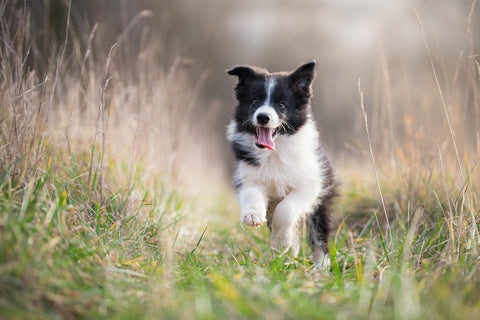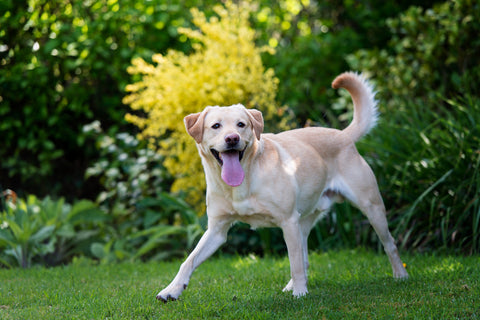
Joint care for dogs: from playful pups to golden oldies
We’re taking a closer look at joint care for dogs – from puppyhood right through to happy, healthy old age! We’ve focussed on what to do to support your dog’s joints at different life stages. However old your dog is, joint care is always an important consideration. We’ve put together our top hints and tips for healthy joints and happy dogs.
Joint care for puppies
Welcoming a new puppy is an exciting time. However, it’s also one of the most important times to care for your dog’s joints.
First, avoid over-exercising your young puppy as this can cause damage to their developing joints. According to The Kennel Club, your pup should get 5 minutes of exercise per month of age, up to twice daily. For more information on preparing for puppy walking, find our blog on the topic here. Keep puppy walks short and fun until your dog is a little more grown up.
Be mindful of the kind of exercise your puppy is doing. For instance, jumping isn’t a good idea until your dog is at least 12 months old, and it’s sensible to restrict rough play with adult dogs or larger pups to avoid accidental injuries.
It’s also important to provide the right nutrition to help your dog develop properly. A supplement like YuMOVE Young & Active can help once they’re on solid food as it aids joint development, supports active joints and promotes mobility.
Remember that different breeds grow at different rates so it’s a good idea to get your vet, rescue centre, or breeder’s advice on what’s best for your growing puppy’s joints.
Dog joint care checklist: Puppyhood
- Support them with a joint supplement such as YuMOVE Young & Active
or a more general supplement like YUM Puppy. - Avoid over-exercising and read our puppy walking blog for more information.
- Do your research and understand how to best care for your breed of puppy’s joints.
Joint care for adolescent dogs
Your puppy becomes an adolescent when they lose their baby teeth – and this stage lasts until they’re a full-grown adult, at around 18 months.
Just like human adolescents, ‘teenage’ pups can be a bit of a handful. Right now, you might be thinking that more exercise is beneficial to tire your dog out, but it’s important that you stick to the 5-minutes-per-month rule. Different breeds grow and mature at different rates, and generally the larger the breed, the longer it will take for their bones to develop fully. Even though your puppy is no longer puppy-sized, it’s important to remember that they’re still growing.
Avoid putting strain on their growing joints; focus on play and stepping up their mental stimulation with challenging brain games and doing lots of fun, positive training. You’ll find that putting in the time now will really develop your bond, too. There are lots of great books out there to get you started on clicker and trick training, while training classes are great for ongoing socialisation, and can be the perfect way to compare notes with other pet parents!
Dog joint care checklist: Adolescent dogs
- Focus on mental stimulation rather than upping your dog’s walk length too quickly.
- Remember that some large breeds continue growing until 18 months and take additional care of their joints in line with this.
- Consider a dog joint supplement such as YuMOVE Young & Active to continue supporting them as they mature into adulthood.
So, you’ve enjoyed puppyhood, and survived adolescence – what’s next in your dog’s joint journey? Here are some tips for dog joint care in adulthood. We’ve looked separately at dogs that are active, stiff, working, and those entering their senior years to make the information as relevant as possible for your furry friend.

Joint care for active dogs
Is your dog an active athlete? Does your pet enjoy dog-sports like CaniCross, Agility, or Flyball – or maybe adventurous treks and countryside hikes? Though such busy dogs may not seem like they need joint supplements, it can help to support their active lifestyle and prevent painful problems down the line.
If you and your dog take part in sports, it’s a good idea to focus on several shorter training sessions instead of one intensive stint. This makes it more fun for your dog and can reduce the risk of injury.
It’s important not to overdo it too early – too much too soon can put strain on their joints. The Kennel Club only allows dogs of 18 months or older to compete in agility competitions, though you can start gentle, fun training sessions from around 12 months old according to ‘Your Dog’ magazine.
Dog joint care checklist: Active dogs
- If training for a sport, focus on shorter training sessions to reduce the risk of injury.
- Consider a joint supplement such as YuMOVE Young & Active to keep your athlete in tip-top condition.
Joint care for young dogs who seem stiff
Unfortunately, some dogs develop stiff joints early on. Breeds to keep an eye on include Labradors, Old English Sheepdogs, Golden Retrievers, Rottweilers, German Shepherds, Alaskan Malamutes, Dachshunds, Newfoundlands, Great Danes, Saint Bernards, Samoyeds, and Mastiffs. If your furry friend is one of these, it’s a good idea to be aware of the signs indicating that it might be time for extra joint support.
These include:
- Starting to lag behind on walks.
- Seeming more reluctant to walk, jump and play.
- Sleeping more.
- Seeming stiff or having trouble getting up after a sleep or rest.
If you spot these signs, it’s a good idea to pop to the vets for a check-up. They can work out what’s going on, and help you modify your dog’s routine. When young dogs develop stiff joints, they can still enjoy great quality of life – you'll just need to keep an eye on things and provide a little more support. From acupuncture for dogs, to hydrotherapy and joint supplements, there’s lots you can do to keep them happy and active.
Dog joint care checklist: Young dogs who seem stiff
- Talk to your vet. The sooner you know what’s going on, the better. They can provide clarity, advice, and prescription medication if necessary.
- Try hydrotherapy. It’s a fantastic low-impact way to support your dog’s joints. Water provides resistance and builds muscle around the joint, so it is stronger and better supported.
- Consider veterinary acupuncture. This is now becoming more popular, and many vets recommend it alongside conventional medication.
- Support their diet with a joint supplement like YuMOVE Dog. This will help to aid stiff joints, support joint structure and promote mobility.
- If your dog has a diagnosed joint problem and is under veterinary care, it’s also worth talking to your vet about our vet-only formulation, YuMOVE ADVANCE for Dogs.

Joint care for working dogs
Do you share your working life with a canine? Whether they’re a sheepdog, sniffer dog, or help you in the field retrieving or flushing, you’ll want to keep them fit for the job. Like dogs who are active for fun, working dogs benefit from joint support to keep them on top of their game.
Start with the basics: great quality food, a comfortable place to rest, and a pre-season fitness routine. Then, you can further support your dog’s joints with a supplement such as YuMOVE Working Dog. This promotes mobility and joint health and supports digestion, so your working dog has more energy and stamina. It’s an extra boost to help them do their best for you every day.
Dog joint care checklist: Working dogs
- Take good general care of your working dog and ensure he or she is well prepared for a hard day’s work.
- Support your dog further with an additional joint supplement, such as YuMOVE Working Dog.
Joint care for older dogs
Old age is when your dog’s joints need a little extra support – and thankfully, there’s a lot you can do to make sure your golden oldie is getting the most from life.
As your dog gets older, it’s important to keep up their exercise. Though older dogs may prefer to take a more sedate pace, daily exercise is vital to maintain a healthy weight and provide a good quality of life. From taking frequent, shorter walks to changing the activities you enjoy together, there are lots of ways to keep your senior dog active – we’ve written a whole blog about exercise for older dogs here.
Dog joint checklist: Older dogs
-
Change your activities to suit your dog as they enter their senior years – this may not be the time to introduce Fly Ball!
-
Adapt your walks so your dog still enjoys them; this may mean shorter, more frequent walks or easier terrain.
-
Senior dogs often suffer from stiffness and could benefit from a joint supplement; try YuMOVE Dog or YuMOVE Plus if your dog is starting to feel stiffer.
Using our care checklists as a guide, you’ll be able to support your dog to live a healthy, active life from puppyhood right into old age. Feel free to use the social buttons below to share this article with your fellow pet parents.
If you have any more questions, be sure to get in touch – we love to hear from you! Alternatively, you can find us and our friendly pet-loving community on Facebook and Instagram.





